Recent Advances in Wearable Textile-Based Triboelectric Nanogenerators
Abstract
:1. Introduction
2. Different Modes of Operation of T-TENGs
2.1. Contact Separation (CS) Mode
2.2. Single Electrode (SE) Mode
2.3. Lateral Sliding (LS) Mode
2.4. Free-Standing Triboelectric-Layer (FT) Mode
3. Fabrication Methods of T-TENGs
3.1. Fiber-Based TENGs


3.2. Fabric-Based T-TENG
3.3. T-TENGs with Fiber-Based Structure
3.4. Fabrication of Nanofibers for TENG
4. Integration of T-TENG with Textile Energy Storage Device
5. Application of T-TENGs
5.1. Applications in Self-Powered Pressure Sensors
5.2. Other Different Applications
6. Summary and Perspectives
Funding
Acknowledgments
Conflicts of Interest
References
- Lacks, D.J.; Shinbrot, T. Long-standing and unresolved issues in triboelectric charging. Nat. Rev. Chem. 2019, 3, 465–476. [Google Scholar] [CrossRef]
- Johnson, A.P.; Cleaves, H.J.; Dworkin, J.P.; Glavin, D.P.; Lazcano, A.; Bada, J.L. The Miller Volcanic Spark Discharge Experiment. Science 2008, 322, 404. [Google Scholar] [CrossRef]
- Wilcke, J.C. Dispvtatio Physica Experimentalis, De Electricitatibvs Contrariis: Qvam Consentiente. In Academia Rostochiensi, Ad D. XIII. Octobr. A. MDCCLVII. Adler, 1757. Available online: https://books.google.co.in/books/about/Disputatio_physica_experimentalis_de_ele.html?id=2yJTzwEACAAJ&redir_esc=y (accessed on 8 August 2024).
- Van De Graaff, R.J.; Compton, K.T.; Van Atta, L.C. The electrostatic production of high voltage for nuclear investigations. Phys. Rev. 1933, 43, 149. [Google Scholar] [CrossRef]
- Qi, Y.; McAlpine, M.C. Nanotechnology-enabled flexible and biocompatible energy harvesting. Energy Environ. Sci. 2010, 3, 1275–1285. [Google Scholar] [CrossRef]
- Bedeloglu, A.C.; Koeppe, R.; Demir, A.; Bozkurt, Y.; Sariciftci, N.S. Development of energy generating photovoltaic textile structures for smart applications. Fibers Polym. 2010, 11, 378–383. [Google Scholar] [CrossRef]
- Mather, R.R.; Wilson, J.I. Fabrication of photovoltaic textiles. Coatings 2017, 7, 63. [Google Scholar] [CrossRef]
- Cao, Z.; Tudor, M.J.; Torah, R.N.; Beeby, S.P. Screen printable flexible BiTe–SbTe-based composite thermoelectric materials on textiles for wearable applications. IEEE Trans. Electron Devices 2016, 63, 4024–4030. [Google Scholar] [CrossRef]
- Lee, J.A.; Aliev, A.E.; Bykova, J.S.; de Andrade, M.J.; Kim, D.; Sim, H.J.; Lepró, X.; Zakhidov, A.A.; Lee, J.-B.; Spinks, G.M.; et al. Woven-Yarn Thermoelectric Textiles. Adv. Mater. 2016, 28, 5038–5044. [Google Scholar] [CrossRef]
- Wu, Q.; Hu, J. A novel design for a wearable thermoelectric generator based on 3D fabric structure. Smart Mater. Struct. 2017, 26, 045037. [Google Scholar] [CrossRef]
- Wu, W.; Bai, S.; Yuan, M.; Qin, Y.; Wang, Z.L.; Jing, T. Lead zirconate titanate nanowire textile nanogenerator for wearable energy-harvesting and self-powered devices. ACS Nano 2012, 6, 6231–6235. [Google Scholar] [CrossRef]
- Soin, N.; Shah, T.H.; Anand, S.C.; Geng, J.; Pornwannachai, W.; Mandal, P.; Reid, D.; Sharma, S.; Hadimani, R.L.; Bayramol, D.V. Novel “3-D spacer” all fibre piezoelectric textiles for energy harvesting applications. Energy Environ. Sci. 2014, 7, 1670–1679. [Google Scholar] [CrossRef]
- Almusallam, A.; Luo, Z.; Komolafe, A.; Yang, K.; Robinson, A.; Torah, R.; Beeby, S. Flexible piezoelectric nano-composite films for kinetic energy harvesting from textiles. Nano Energy 2017, 33, 146–156. [Google Scholar] [CrossRef]
- Fan, F.-R.; Tian, Z.-Q.; Wang, Z.L. Flexible triboelectric generator. Nano Energy 2012, 1, 328–334. [Google Scholar] [CrossRef]
- Xie, Y.; Wang, S.; Lin, L.; Jing, Q.; Lin, Z.-H.; Niu, S.; Wu, Z.; Wang, Z.L. Rotary triboelectric nanogenerator based on a hybridized mechanism for harvesting wind energy. ACS Nano 2013, 7, 7119–7125. [Google Scholar] [CrossRef]
- Yang, Y.; Zhu, G.; Zhang, H.; Chen, J.; Zhong, X.; Lin, Z.-H.; Su, Y.; Bai, P.; Wen, X.; Wang, Z.L. Triboelectric nanogenerator for harvesting wind energy and as self-powered wind vector sensor system. ACS Nano 2013, 7, 9461–9468. [Google Scholar] [CrossRef]
- Seol, M.-L.; Woo, J.-H.; Jeon, S.-B.; Kim, D.; Park, S.-J.; Hur, J.; Choi, Y.-K. Vertically stacked thin triboelectric nanogenerator for wind energy harvesting. Nano Energy 2015, 14, 201–208. [Google Scholar] [CrossRef]
- Wang, X.; Niu, S.; Yin, Y.; Yi, F.; You, Z.; Wang, Z.L. Triboelectric nanogenerator based on fully enclosed rolling spherical structure for harvesting low-frequency water wave energy. Adv. Energy Mater. 2015, 5, 1501467. [Google Scholar] [CrossRef]
- Liang, Q.; Yan, X.; Gu, Y.; Zhang, K.; Liang, M.; Lu, S.; Zheng, X.; Zhang, Y. Highly transparent triboelectric nanogenerator for harvesting water-related energy reinforced by antireflection coating. Sci. Rep. 2015, 5, 9080. [Google Scholar] [CrossRef]
- Bai, P.; Zhu, G.; Lin, Z.-H.; Jing, Q.; Chen, J.; Zhang, G.; Ma, J.; Wang, Z.L. Integrated multilayered triboelectric nanogenerator for harvesting biomechanical energy from human motions. ACS Nano 2013, 7, 3713–3719. [Google Scholar] [CrossRef]
- Hou, T.-C.; Yang, Y.; Zhang, H.; Chen, J.; Chen, L.-J.; Wang, Z.L. Triboelectric nanogenerator built inside shoe insole for harvesting walking energy. Nano Energy 2013, 2, 856–862. [Google Scholar] [CrossRef]
- Proto, A.; Penhaker, M.; Conforto, S.; Schmid, M. Nanogenerators for human body energy harvesting. Trends Biotechnol. 2017, 35, 610–624. [Google Scholar] [CrossRef] [PubMed]
- Cui, N.; Gu, L.; Liu, J.; Bai, S.; Qiu, J.; Fu, J.; Kou, X.; Liu, H.; Qin, Y.; Wang, Z.L. High performance sound driven triboelectric nanogenerator for harvesting noise energy. Nano Energy 2015, 15, 321–328. [Google Scholar] [CrossRef]
- Rani, G.M.; Wu, C.-M.; Motora, K.G.; Umapathi, R.; Jose, C.R.M. Acoustic-electric conversion and triboelectric properties of nature-driven CF-CNT based triboelectric nanogenerator for mechanical and sound energy harvesting. Nano Energy 2023, 108, 108211. [Google Scholar] [CrossRef]
- Zhong, J.; Zhang, Y.; Zhong, Q.; Hu, Q.; Hu, B.; Wang, Z.L.; Zhou, J. Fiber-based generator for wearable electronics and mobile medication. ACS Nano 2014, 8, 6273–6280. [Google Scholar] [CrossRef] [PubMed]
- Chen, J.; Guo, H.; Pu, X.; Wang, X.; Xi, Y.; Hu, C. Traditional weaving craft for one-piece self-charging power textile for wearable electronics. Nano Energy 2018, 50, 536–543. [Google Scholar] [CrossRef]
- Pu, X.; Li, L.; Song, H.; Du, C.; Zhao, Z.; Jiang, C.; Cao, G.; Hu, W.; Wang, Z.L. A self-charging power unit by integration of a textile triboelectric nanogenerator and a flexible lithium-ion battery for wearable electronics. Adv. Mater. 2015, 27, 2472–2478. [Google Scholar] [CrossRef]
- Zeng, W.; Shu, L.; Li, Q.; Chen, S.; Wang, F.; Tao, X.M. Fiber-based wearable electronics: A review of materials, fabrication, devices, and applications. Adv. Mater. 2014, 26, 5310–5336. [Google Scholar] [CrossRef]
- Zhang, Q.; Zhang, Z.; Liang, Q.; Gao, F.; Yi, F.; Ma, M.; Liao, Q.; Kang, Z.; Zhang, Y. Green hybrid power system based on triboelectric nanogenerator for wearable/portable electronics. Nano Energy 2019, 55, 151–163. [Google Scholar] [CrossRef]
- Xiong, J.; Lee, P.S. Progress on wearable triboelectric nanogenerators in shapes of fiber, yarn, and textile. Sci. Technol. Adv. Mater. 2019, 20, 837–857. [Google Scholar] [CrossRef]
- Paosangthong, W.; Torah, R.; Beeby, S. Recent progress on textile-based triboelectric nanogenerators. Nano Energy 2019, 55, 401–423. [Google Scholar] [CrossRef]
- Wang, J.; Wang, H.; Thakor, N.V.; Lee, C. Self-powered direct muscle stimulation using a triboelectric nanogenerator (TENG) integrated with a flexible multiple-channel intramuscular electrode. ACS Nano 2019, 13, 3589–3599. [Google Scholar] [CrossRef] [PubMed]
- Fan, F.R.; Tang, W.; Wang, Z.L. Flexible nanogenerators for energy harvesting and self-powered electronics. Adv. Mater. 2016, 28, 4283–4305. [Google Scholar] [CrossRef] [PubMed]
- Dong, Y.; Mallineni, S.S.K.; Maleski, K.; Behlow, H.; Mochalin, V.N.; Rao, A.M.; Gogotsi, Y.; Podila, R. Metallic MXenes: A new family of materials for flexible triboelectric nanogenerators. Nano Energy 2018, 44, 103–110. [Google Scholar] [CrossRef]
- Huang, T.; Wang, C.; Yu, H.; Wang, H.; Zhang, Q.; Zhu, M. Human walking-driven wearable all-fiber triboelectric nanogenerator containing electrospun polyvinylidene fluoride piezoelectric nanofibers. Nano Energy 2015, 14, 226–235. [Google Scholar] [CrossRef]
- Ko, Y.H.; Nagaraju, G.; Yu, J.S. Multi-stacked PDMS-based triboelectric generators with conductive textile for efficient energy harvesting. RSC Adv. 2015, 5, 6437–6442. [Google Scholar] [CrossRef]
- Liu, L.; Pan, J.; Chen, P.; Zhang, J.; Yu, X.; Ding, X.; Wang, B.; Sun, X.; Peng, H. A triboelectric textile templated by a three-dimensionally penetrated fabric. J. Mater. Chem. A 2016, 4, 6077–6083. [Google Scholar] [CrossRef]
- Das, P.S.; Park, J.Y.; Kim, D.H. Vacuum filtered conductive nylon membrane-based flexible TENG for wearable electronics. Micro Nano Lett. 2017, 12, 697–700. [Google Scholar] [CrossRef]
- Sim, H.J.; Choi, C.; Kim, S.H.; Kim, K.M.; Lee, C.J.; Kim, Y.T.; Lepró, X.; Baughman, R.H.; Kim, S.J. Stretchable triboelectric fiber for self-powered kinematic sensing textile. Sci. Rep. 2016, 6, 35153. [Google Scholar] [CrossRef]
- Dong, K.; Deng, J.; Zi, Y.; Wang, Y.C.; Xu, C.; Zou, H.; Ding, W.; Dai, Y.; Gu, B.; Sun, B. 3D orthogonal woven triboelectric nanogenerator for effective biomechanical energy harvesting and as self-powered active motion sensors. Adv. Mater. 2017, 29, 1702648. [Google Scholar] [CrossRef]
- Niu, S.; Wang, S.; Lin, L.; Liu, Y.; Zhou, Y.S.; Hu, Y.; Wang, Z.L. Theoretical study of contact-mode triboelectric nanogenerators as an effective power source. Energy Environ. Sci. 2013, 6, 3576–3583. [Google Scholar] [CrossRef]
- Niu, S.; Zhou, Y.S.; Wang, S.; Liu, Y.; Lin, L.; Bando, Y.; Wang, Z.L. Simulation method for optimizing the performance of an integrated triboelectric nanogenerator energy harvesting system. Nano Energy 2014, 8, 150–156. [Google Scholar] [CrossRef]
- Kwak, S.S.; Kim, H.; Seung, W.; Kim, J.; Hinchet, R.; Kim, S.-W. Fully stretchable textile triboelectric nanogenerator with knitted fabric structures. ACS Nano 2017, 11, 10733–10741. [Google Scholar] [CrossRef] [PubMed]
- Xiong, J.; Cui, P.; Chen, X.; Wang, J.; Parida, K.; Lin, M.-F.; Lee, P.S. Skin-touch-actuated textile-based triboelectric nanogenerator with black phosphorus for durable biomechanical energy harvesting. Nat. Commun. 2018, 9, 4280. [Google Scholar] [CrossRef] [PubMed]
- Ning, C.; Tian, L.; Zhao, X.; Xiang, S.; Tang, Y.; Liang, E.; Mao, Y. Washable textile-structured single-electrode triboelectric nanogenerator for self-powered wearable electronics. J. Mater. Chem. A 2018, 6, 19143–19150. [Google Scholar] [CrossRef]
- Bai, P.; Zhu, G.; Liu, Y.; Chen, J.; Jing, Q.; Yang, W.; Ma, J.; Zhang, G.; Wang, Z.L. Cylindrical rotating triboelectric nanogenerator. ACS Nano 2013, 7, 6361–6366. [Google Scholar] [CrossRef]
- Lin, L.; Wang, S.; Xie, Y.; Jing, Q.; Niu, S.; Hu, Y.; Wang, Z.L. Segmentally structured disk triboelectric nanogenerator for harvesting rotational mechanical energy. Nano Lett. 2013, 13, 2916–2923. [Google Scholar] [CrossRef]
- Cui, N.; Liu, J.; Gu, L.; Bai, S.; Chen, X.; Qin, Y. Wearable triboelectric generator for powering the portable electronic devices. ACS Appl. Mater. Interfaces 2015, 7, 18225–18230. [Google Scholar] [CrossRef]
- Zhou, T.; Zhang, C.; Han, C.B.; Fan, F.R.; Tang, W.; Wang, Z.L. Woven structured triboelectric nanogenerator for wearable devices. ACS Appl. Mater. Interfaces 2014, 6, 14695–14701. [Google Scholar] [CrossRef]
- Zhang, L.; Su, C.; Cui, X.; Li, P.; Wang, Z.; Gu, L.; Tang, Z. Free-standing triboelectric layer-based full fabric wearable nanogenerator for efficient mechanical energy harvesting. ACS Appl. Electron. Mater. 2020, 2, 3366–3372. [Google Scholar] [CrossRef]
- Diaz, A.; Felix-Navarro, R. A semi-quantitative tribo-electric series for polymeric materials: The influence of chemical structure and properties. J. Electrost. 2004, 62, 277–290. [Google Scholar] [CrossRef]
- Vigo, T.L. Textile Processing and Properties: Preparation, Dyeing, Finishing and Performance; Elsevier: Amsterdam, The Netherlands, 2013; Available online: https://shop.elsevier.com/books/textile-processing-and-properties/vigo/978-0-444-88224-0 (accessed on 8 August 2024).
- Zhao, Z.; Hu, Y. Textile Triboelectric Nanogenerator: Future Smart Wearable Energy-Integration Technology. Adv. Mater. Technol. 2024, 2302012. Available online: https://onlinelibrary.wiley.com/doi/abs/10.1002/admt.202302012 (accessed on 8 August 2024).
- Dolez, P.I. Energy harvesting materials and structures for smart textile applications: Recent progress and path forward. Sensors 2021, 21, 6297. [Google Scholar] [CrossRef] [PubMed]
- Ali, I.; Dulal, M.; Karim, N.; Afroj, S. 2D Material-Based Wearable Energy Harvesting Textiles: A Review. Small Struct. 2024, 5, 2300282. [Google Scholar] [CrossRef]
- Chen, Y.; Ling, Y.; Yin, R. Fiber/yarn-based triboelectric nanogenerators (TENGs): Fabrication strategy, structure, and application. Sensors 2022, 22, 9716. [Google Scholar] [CrossRef] [PubMed]
- Zhu, J.; Zhu, P.; Yang, Q.; Chen, T.; Wang, J.; Li, J. A fully stretchable textile-based triboelectric nanogenerator for human motion monitoring. Mater. Lett. 2020, 280, 128568. [Google Scholar] [CrossRef]
- Lai, Y.C.; Deng, J.; Zhang, S.L.; Niu, S.; Guo, H.; Wang, Z.L. Single-thread-based wearable and highly stretchable triboelectric nanogenerators and their applications in cloth-based self-powered human-interactive and biomedical sensing. Adv. Funct. Mater. 2017, 27, 1604462. [Google Scholar] [CrossRef]
- Yu, A.; Pu, X.; Wen, R.; Liu, M.; Zhou, T.; Zhang, K.; Zhang, Y.; Zhai, J.; Hu, W.; Wang, Z.L. Core–shell-yarn-based triboelectric nanogenerator textiles as power cloths. ACS Nano 2017, 11, 12764–12771. [Google Scholar] [CrossRef]
- Yu, X.; Pan, J.; Zhang, J.; Sun, H.; He, S.; Qiu, L.; Lou, H.; Sun, X.; Peng, H. A coaxial triboelectric nanogenerator fiber for energy harvesting and sensing under deformation. J. Mater. Chem. A 2017, 5, 6032–6037. [Google Scholar] [CrossRef]
- Guan, X.; Xu, B.; Wu, M.; Jing, T.; Yang, Y.; Gao, Y. Breathable, washable and wearable woven-structured triboelectric nanogenerators utilizing electrospun nanofibers for biomechanical energy harvesting and self-powered sensing. Nano Energy 2021, 80, 105549. [Google Scholar] [CrossRef]
- Zhang, L.; Su, C.; Cheng, L.; Cui, N.; Gu, L.; Qin, Y.; Yang, R.; Zhou, F. Enhancing the performance of textile triboelectric nanogenerators with oblique microrod arrays for wearable energy harvesting. ACS Appl. Mater. Interfaces 2019, 11, 26824–26829. [Google Scholar] [CrossRef]
- Somkuwar, V.U.; Pragya, A.; Kumar, B. Structurally engineered textile-based triboelectric nanogenerator for energy harvesting application. J. Mater. Sci. 2020, 55, 5177–5189. [Google Scholar] [CrossRef]
- Liu, J.; Gu, L.; Cui, N.; Bai, S.; Liu, S.; Xu, Q.; Qin, Y.; Yang, R.; Zhou, F. Core-shell fiber-based 2D woven triboelectric nanogenerator for effective motion energy harvesting. Nanoscale Res. Lett. 2019, 14, 311. [Google Scholar] [CrossRef] [PubMed]
- Huang, T.; Zhang, J.; Yu, B.; Yu, H.; Long, H.; Wang, H.; Zhang, Q.; Zhu, M. Fabric texture design for boosting the performance of a knitted washable textile triboelectric nanogenerator as wearable power. Nano Energy 2019, 58, 375–383. [Google Scholar] [CrossRef]
- Peng, F.; Liu, D.; Zhao, W.; Zheng, G.; Ji, Y.; Dai, K.; Mi, L.; Zhang, D.; Liu, C.; Shen, C. Facile fabrication of triboelectric nanogenerator based on low-cost thermoplastic polymeric fabrics for large-area energy harvesting and self-powered sensing. Nano Energy 2019, 65, 104068. [Google Scholar] [CrossRef]
- Shen, Y.; Chen, C.; Chen, L.; Shang, L.; Wang, T.; Wang, K.; Zhao, Y.; Hou, R.; Cong, H.; Jiang, G. Mass-production of biomimetic fur knitted triboelectric fabric for smart home and healthcare. Nano Energy 2024, 125, 109510. [Google Scholar] [CrossRef]
- Wang, W.; Yu, A.; Liu, X.; Liu, Y.; Zhang, Y.; Zhu, Y.; Lei, Y.; Jia, M.; Zhai, J.; Wang, Z.L. Large-scale fabrication of robust textile triboelectric nanogenerators. Nano Energy 2020, 71, 104605. [Google Scholar] [CrossRef]
- Pyo, S.; Kim, M.-O.; Kwon, D.-S.; Kim, W.; Yang, J.-H.; Cho, H.S.; Lee, J.H.; Kim, J. All-textile wearable triboelectric nanogenerator using pile-embroidered fibers for enhancing output power. Smart Mater. Struct. 2020, 29, 055026. [Google Scholar] [CrossRef]
- Miao, Y.; Zhou, M.; Yi, J.; Wang, Y.; Tian, G.; Zhang, H.; Huang, W.; Wang, W.; Wu, R.; Ma, L. Woven fabric triboelectric nanogenerators for human-computer interaction and physical health monitoring. Nano Res. 2024, 17, 5540–5548. [Google Scholar] [CrossRef]
- Zhang, J.-H.; Li, Y.; Du, J.; Hao, X.; Huang, H. A high-power wearable triboelectric nanogenerator prepared from self-assembled electrospun poly (vinylidene fluoride) fibers with a heart-like structure. J. Mater. Chem. A 2019, 7, 11724–11733. [Google Scholar] [CrossRef]
- Kim, Y.; Wu, X.; Oh, J.H. Fabrication of triboelectric nanogenerators based on electrospun polyimide nanofibers membrane. Sci. Rep. 2020, 10, 2742. [Google Scholar] [CrossRef]
- Pu, X.; Zha, J.-W.; Zhao, C.-L.; Gong, S.-B.; Gao, J.-F.; Li, R.K. Flexible PVDF/nylon-11 electrospun fibrous membranes with aligned ZnO nanowires as potential triboelectric nanogenerators. Chem. Eng. J. 2020, 398, 125526. [Google Scholar] [CrossRef]
- Wee, G.; Soh, H.Z.; Cheah, Y.L.; Mhaisalkar, S.G.; Srinivasan, M. Synthesis and electrochemical properties of electrospun V2O5 nanofibers as supercapacitor electrodes. J. Mater. Chem. 2010, 20, 6720–6725. [Google Scholar] [CrossRef]
- Binitha, G.; Soumya, M.; Madhavan, A.A.; Praveen, P.; Balakrishnan, A.; Subramanian, K.; Reddy, M.; Nair, S.V.; Nair, A.S.; Sivakumar, N. Electrospun α-Fe2O3 nanostructures for supercapacitor applications. J. Mater. Chem. A 2013, 1, 11698–11704. [Google Scholar] [CrossRef]
- Hao, J.; Lei, G.; Li, Z.; Wu, L.; Xiao, Q.; Wang, L. A novel polyethylene terephthalate nonwoven separator based on electrospinning technique for lithium ion battery. J. Membr. Sci. 2013, 428, 11–16. [Google Scholar] [CrossRef]
- Song, M.Y.; Ihn, K.J.; Jo, S.M.; Kim, D.Y. Electrospun TiO2 electrodes for dye-sensitized solar cells. Nanotechnology 2004, 15, 1861. [Google Scholar] [CrossRef]
- Chen, J.-Y.; Chiu, Y.-C.; Shih, C.-C.; Wu, W.-C.; Chen, W.-C. Electrospun nanofibers with dual plasmonic-enhanced luminescent solar concentrator effects for high-performance organic photovoltaic cells. J. Mater. Chem. A 2015, 3, 15039–15048. [Google Scholar] [CrossRef]
- Li, H.; Zhang, B.; Liu, W.; Lin, B.; Ou, Q.; Wang, H.; Fang, M.; Liu, D.; Neelakandan, S.; Wang, L. Effects of an electrospun fluorinated poly (ether ether ketone) separator on the enhanced safety and electrochemical properties of lithium ion batteries. Electrochim. Acta 2018, 290, 150–164. [Google Scholar] [CrossRef]
- Choi, S.; Fu, Y.-Z.; Ahn, Y.; Jo, S.; Manthiram, A. Nafion-impregnated electrospun polyvinylidene fluoride composite membranes for direct methanol fuel cells. J. Power Sources 2008, 180, 167–171. [Google Scholar] [CrossRef]
- Jang, S.; Kim, Y.; Lee, S.; Oh, J.H. Optimization of electrospinning parameters for electrospun nanofiber-based triboelectric nanogenerators. Int. J. Precis. Eng. Manuf.-Green Technol. 2019, 6, 731–739. [Google Scholar] [CrossRef]
- Choi, G.-J.; Baek, S.-H.; Lee, S.-S.; Khan, F.; Kim, J.H.; Park, I.-K. Performance enhancement of triboelectric nanogenerators based on polyvinylidene fluoride/graphene quantum dot composite nanofibers. J. Alloys Compd. 2019, 797, 945–951. [Google Scholar] [CrossRef]
- Kong, T.-H.; Lee, S.-S.; Choi, G.-J.; Park, I.-K. Churros-like polyvinylidene fluoride nanofibers for enhancing output performance of triboelectric nanogenerators. ACS Appl. Mater. Interfaces 2020, 12, 17824–17832. [Google Scholar] [CrossRef]
- Chen, C.; Guo, H.; Chen, L.; Wang, Y.-C.; Pu, X.; Yu, W.; Wang, F.; Du, Z.; Wang, Z.L. Direct current fabric triboelectric nanogenerator for biomotion energy harvesting. ACS Nano 2020, 14, 4585–4594. [Google Scholar] [CrossRef] [PubMed]
- Qi, J.; Wang, A.C.; Yang, W.; Zhang, M.; Hou, C.; Zhang, Q.; Li, Y.; Wang, H. Hydrogel-based hierarchically wrinkled stretchable nanofibrous membrane for high performance wearable triboelectric nanogenerator. Nano Energy 2020, 67, 104206. [Google Scholar] [CrossRef]
- Bayan, S.; Pal, S.; Ray, S.K. Interface engineered silver nanoparticles decorated g-C3N4 nanosheets for textile based triboelectric nanogenerators as wearable power sources. Nano Energy 2022, 94, 106928. [Google Scholar] [CrossRef]
- Zhao, Z.; Huang, Q.; Yan, C.; Liu, Y.; Zeng, X.; Wei, X.; Hu, Y.; Zheng, Z. Machine-washable and breathable pressure sensors based on triboelectric nanogenerators enabled by textile technologies. Nano Energy 2020, 70, 104528. [Google Scholar] [CrossRef]
- Ma, L.; Zhou, M.; Wu, R.; Patil, A.; Gong, H.; Zhu, S.; Wang, T.; Zhang, Y.; Shen, S.; Dong, K. Continuous and scalable manufacture of hybridized nano-micro triboelectric yarns for energy harvesting and signal sensing. ACS Nano 2020, 14, 4716–4726. [Google Scholar] [CrossRef]
- Fan, W.; He, Q.; Meng, K.; Tan, X.; Zhou, Z.; Zhang, G.; Yang, J.; Wang, Z.L. Machine-knitted washable sensor array textile for precise epidermal physiological signal monitoring. Sci. Adv. 2020, 6, eaay2840. [Google Scholar] [CrossRef]
- Gan, L.; Geng, A.; Wu, Y.; Wang, L.; Fang, X.; Xu, L.; Mei, C. Antibacterial, flexible, and conductive membrane based on MWCNTs/Ag coated electro-spun PLA nanofibrous scaffolds as wearable fabric for body motion sensing. Polymers 2020, 12, 120. [Google Scholar] [CrossRef]
- Zhang, S.; Rana, S.S.; Bhatta, T.; Pradhan, G.B.; Sharma, S.; Song, H.; Jeong, S.; Park, J.Y. 3D printed smart glove with pyramidal MXene/Ecoflex composite-based toroidal triboelectric nanogenerators for wearable human-machine interaction applications. Nano Energy 2023, 106, 108110. [Google Scholar] [CrossRef]
- Yang, J.; Hong, K.; Hao, Y.; Zhu, X.; Su, J.; Su, W.; Zhang, H.; Qin, Y.; Zhang, C.; Li, X. Mica/nylon composite nanofiber film based wearable triboelectric sensor for object recognition. Nano Energy 2024, 129, 110056. [Google Scholar] [CrossRef]
- Ning, C.; Xiang, S.; Sun, X.; Zhao, X.; Wei, C.; Li, L.; Zheng, G.; Dong, K. Highly stretchable kirigami-patterned nanofiber-based nanogenerators for harvesting human motion energy to power wearable electronics. Mater. Futures 2024, 3, 025101. [Google Scholar] [CrossRef]
- Sadanandan, K.S.; Saadi, Z.; Murphy, C.; Grikalaite, I.; Craciun, M.F.; Neves, A.I. Fabric-based triboelectric nanogenerators with ultrasonic spray coated graphene electrodes. Nano Energy 2023, 116, 108797. [Google Scholar] [CrossRef]
- Aliyana, A.K.; Bairagi, S.; Kumar, C.; Mulvihill, D.M.; Stylios, G.K. Investigating Superior Performance by Configuring Bimetallic Electrodes on Fabric Triboelectric Nanogenerators (F-TENGs) for IoT Enabled Touch Sensor Applications. Nano Energy 2024, 130, 110125. [Google Scholar] [CrossRef]
- Yu, Z.; Zhu, Z.; Wang, Y.; Wang, J.; Zhao, Y.; Zhang, J.; Qin, Y.; Jiang, Q.; He, H. Wearable cotton fabric-based single-electrode-mode triboelectric nanogenerator for self-powered human motion monitoring. Cellulose 2023, 30, 5355–5371. [Google Scholar] [CrossRef]
- Hao, Y.; Zhang, Y.; Mensah, A.; Liao, S.; Lv, P.; Wei, Q. Scalable, ultra-high stretchable and conductive fiber triboelectric nanogenerator for biomechanical sensing. Nano Energy 2023, 109, 108291. [Google Scholar] [CrossRef]
- Chung, C.-K.; Huang, Y.-J.; Wang, T.-K.; Lo, Y.-L. Fiber-Based Triboelectric Nanogenerator for Mechanical Energy Harvesting and Its Application to a Human–Machine Interface. Sensors 2022, 22, 9632. [Google Scholar] [CrossRef] [PubMed]
- He, Y.; Wang, H.; Sha, Z.; Boyer, C.; Wang, C.-H.; Zhang, J. Enhancing output performance of PVDF-HFP fiber-based nanogenerator by hybridizing silver nanowires and perovskite oxide nanocrystals. Nano Energy 2022, 98, 107343. [Google Scholar] [CrossRef]
- Wu, F.; Lan, B.; Cheng, Y.; Zhou, Y.; Hossain, G.; Grabher, G.; Shi, L.; Wang, R.; Sun, J. A stretchable and helically structured fiber nanogenerator for multifunctional electronic textiles. Nano Energy 2022, 101, 107588. [Google Scholar] [CrossRef]
- Barras, R.; dos Santos, A.; Calmeiro, T.; Fortunato, E.; Martins, R.; Águas, H.; Barquinha, P.; Igreja, R.; Pereira, L. Porous PDMS conformable coating for high power output carbon fibers/ZnO nanorod-based triboelectric energy harvesters. Nano Energy 2021, 90, 106582. [Google Scholar] [CrossRef]
- Liu, J.; Yu, D.; Zheng, Z.; Huangfu, G.; Guo, Y. Lead-free BiFeO3 film on glass fiber fabric: Wearable hybrid piezoelectric-triboelectric nanogenerator. Ceram. Int. 2021, 47, 3573–3579. [Google Scholar] [CrossRef]
- Wang, J.; He, J.; Ma, L.; Yao, Y.; Zhu, X.; Peng, L.; Liu, X.; Li, K.; Qu, M. A humidity-resistant, stretchable and wearable textile-based triboelectric nanogenerator for mechanical energy harvesting and multifunctional self-powered haptic sensing. Chem. Eng. J. 2021, 423, 130200. [Google Scholar] [CrossRef]
- Guo, Y.; Zhang, X.-S.; Wang, Y.; Gong, W.; Zhang, Q.; Wang, H.; Brugger, J. All-fiber hybrid piezoelectric-enhanced triboelectric nanogenerator for wearable gesture monitoring. Nano Energy 2018, 48, 152–160. [Google Scholar] [CrossRef]
- Dong, K.; Wang, Y.-C.; Deng, J.; Dai, Y.; Zhang, S.L.; Zou, H.; Gu, B.; Sun, B.; Wang, Z.L. A highly stretchable and washable all-yarn-based self-charging knitting power textile composed of fiber triboelectric nanogenerators and supercapacitors. ACS Nano 2017, 11, 9490–9499. [Google Scholar] [CrossRef] [PubMed]
- Shi, M.; Wu, H.; Zhang, J.; Han, M.; Meng, B.; Zhang, H. Self-powered wireless smart patch for healthcare monitoring. Nano Energy 2017, 32, 479–487. [Google Scholar] [CrossRef]
- Kim, K.; Song, G.; Park, C.; Yun, K.-S. Multifunctional woven structure operating as triboelectric energy harvester, capacitive tactile sensor array, and piezoresistive strain sensor array. Sensors 2017, 17, 2582. [Google Scholar] [CrossRef]
- Zhu, M.; Huang, Y.; Ng, W.S.; Liu, J.; Wang, Z.; Wang, Z.; Hu, H.; Zhi, C. 3D spacer fabric based multifunctional triboelectric nanogenerator with great feasibility for mechanized large-scale production. Nano Energy 2016, 27, 439–446. [Google Scholar] [CrossRef]
- Song, G.; Kim, Y.; Yu, S.; Kim, M.-O.; Park, S.-H.; Cho, S.M.; Velusamy, D.B.; Cho, S.H.; Kim, K.L.; Kim, J. Molecularly engineered surface triboelectric nanogenerator by self-assembled monolayers (METS). Chem. Mater. 2015, 27, 4749–4755. [Google Scholar] [CrossRef]
- Li, S.; Zhong, Q.; Zhong, J.; Cheng, X.; Wang, B.; Hu, B.; Zhou, J. Cloth-based power shirt for wearable energy harvesting and clothes ornamentation. ACS Appl. Mater. Interfaces 2015, 7, 14912–14916. [Google Scholar] [CrossRef]


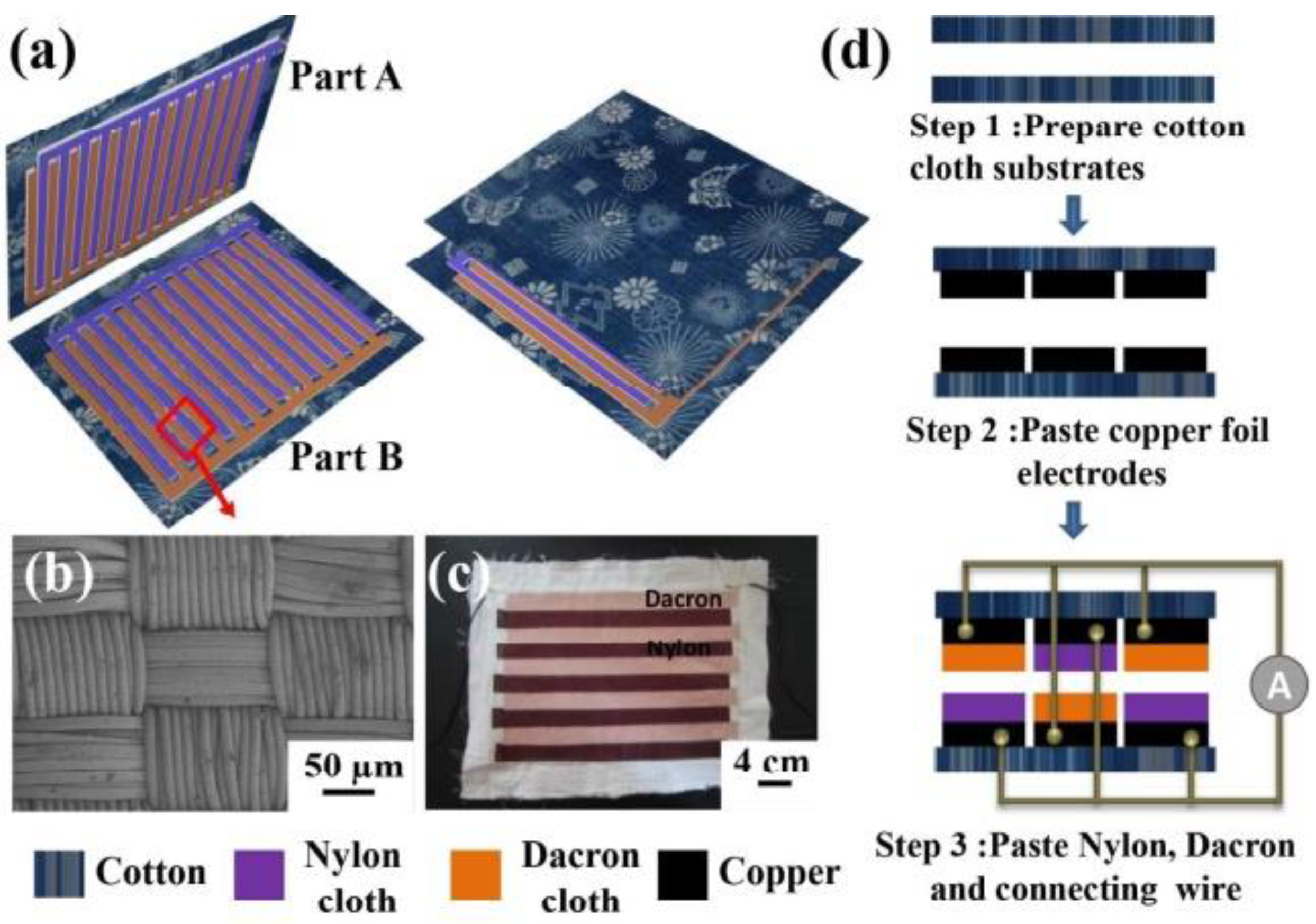


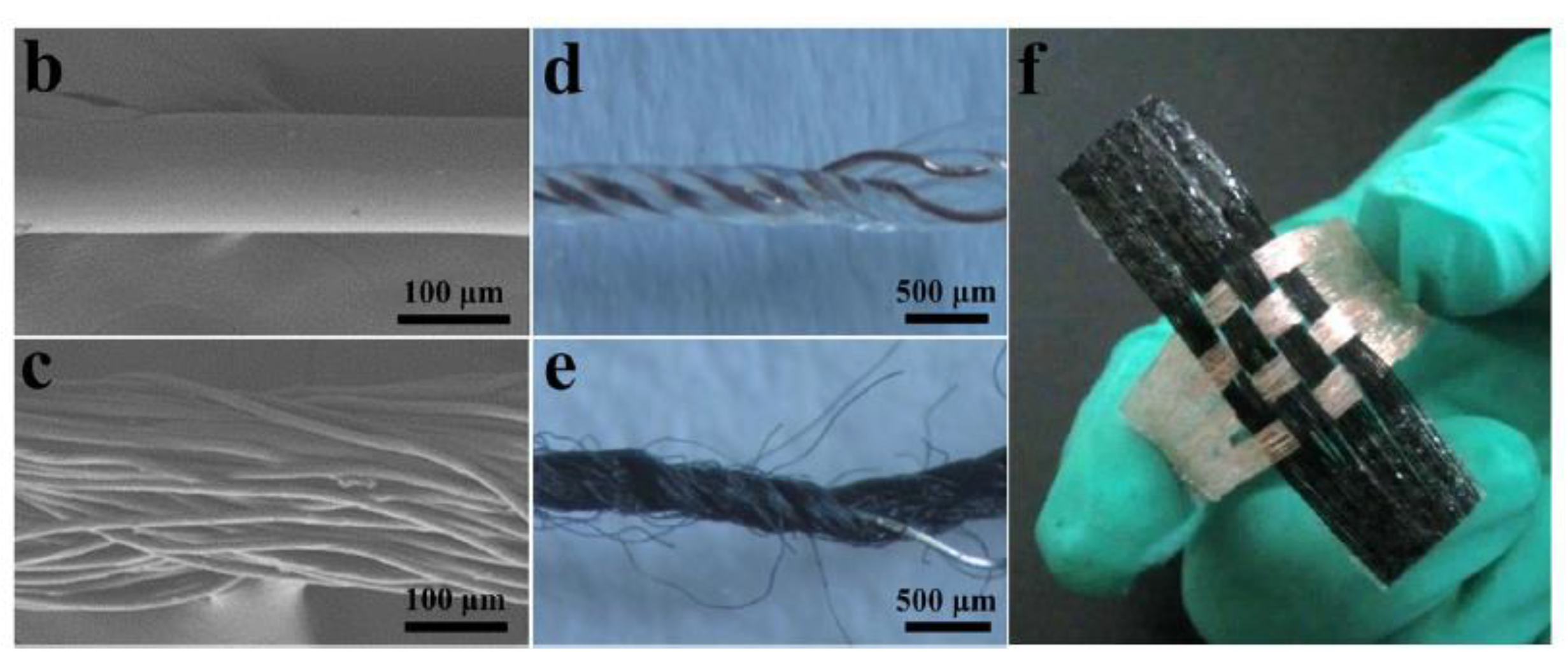

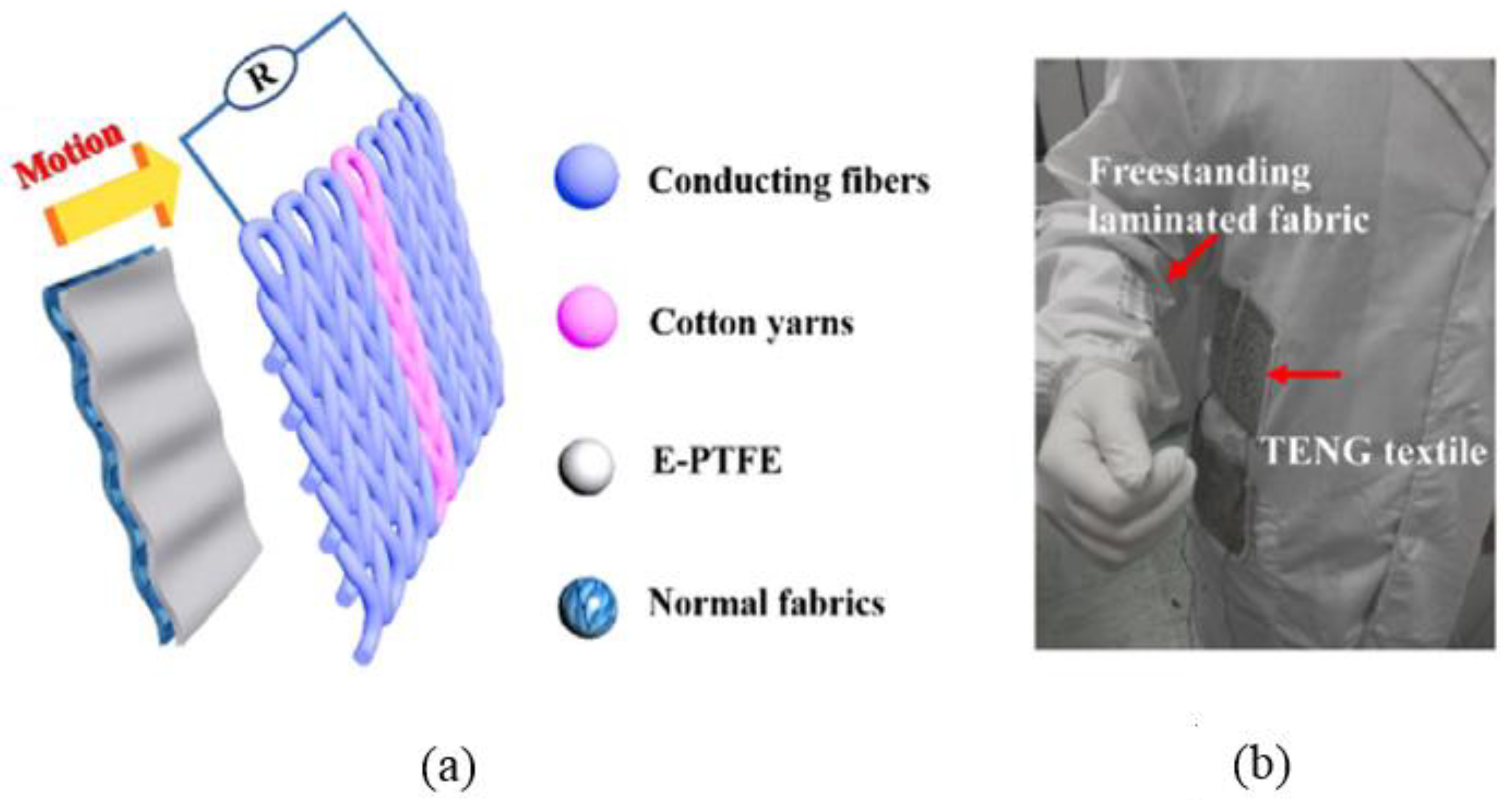

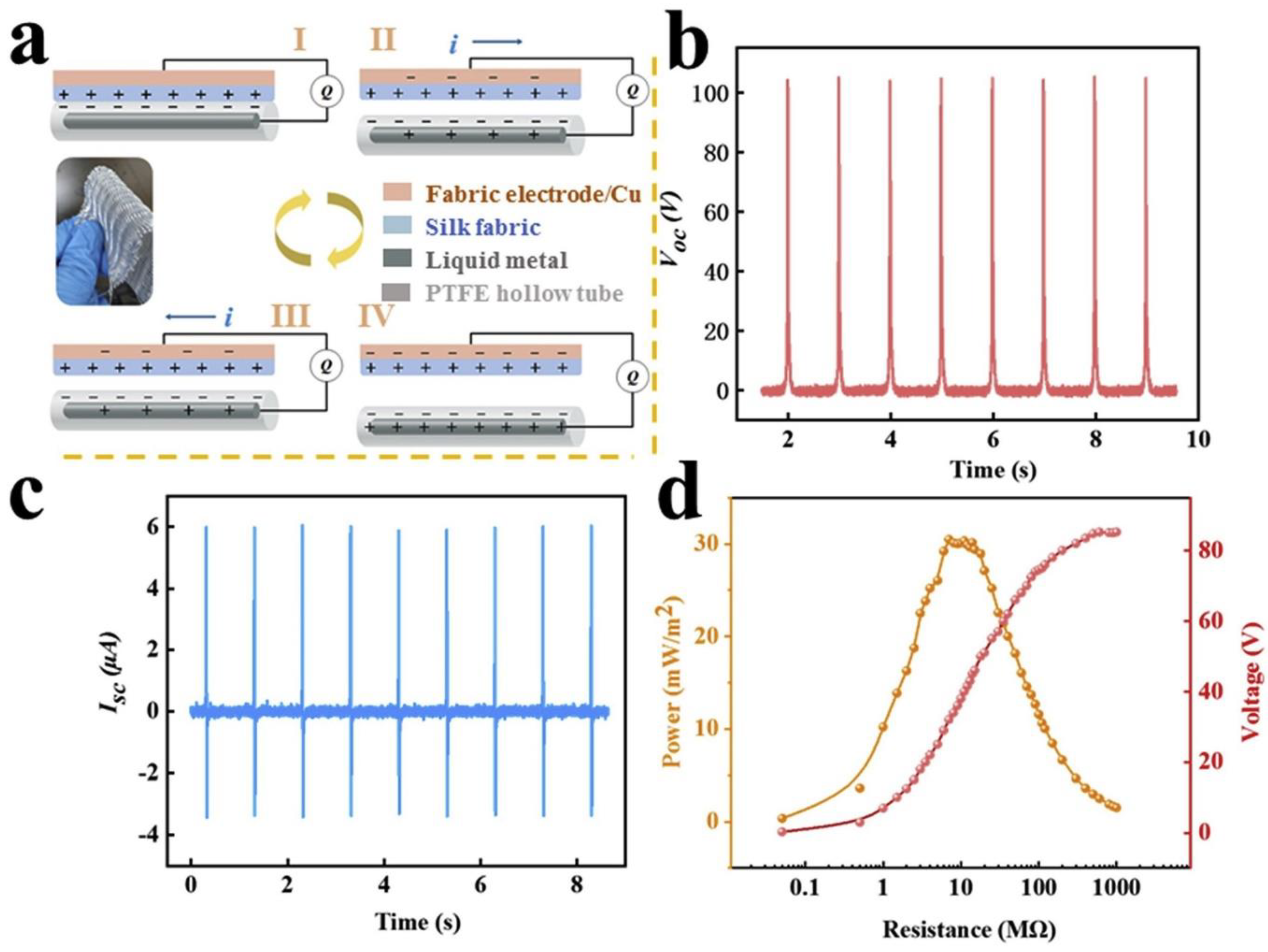

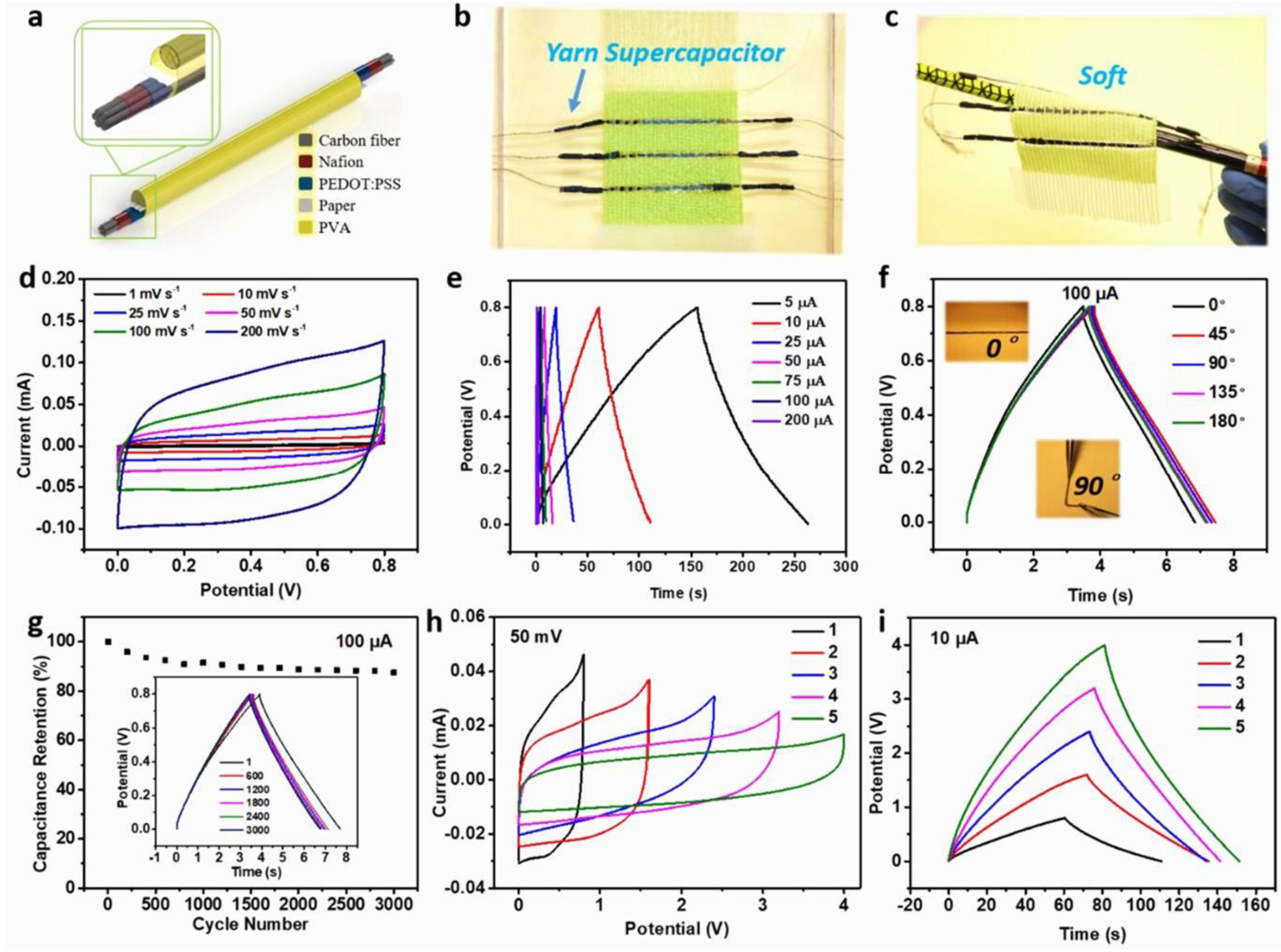

| Samples/Electrodes | Area (cm2) | Peak Power Density (μW/cm2) | Input Energy | Year | Ref. |
|---|---|---|---|---|---|
| Al, wool, PTFE, Ag | 96 | 140 | 1 Kpa, 1 Hz | 2024 | [67] |
| Electrode: MWCNT, PEDOT:PSS, and carbon | 130 | 448 | 88.5 Kpa, 30 Hz | 2024 | [93] |
| Pu, FEP, ecoflux, nylon, Al | 8 | 1182 | 10 N, 3 Hz | 2024 | [92] |
| PDMS, graphene, polyester fabric, nitrile, Cu | 9 | 30 | 20 N, 15 Hz | 2024 | [94] |
| Cu, PET, EcoFlex, bimetallic electrodes | 5 | 299.2 | 8 N, 8 Hz | 2024 | [95] |
| Conductive yarn, cotton yarn, polyester–cotton blended yarn | 17.35 | - | 25 N, 5 Hz | 2023 | [70] |
| Polypyrrole, PTFE, Ag | 35 | - | 4 N, 2.5 Hz | 2023 | [96] |
| TiAlC2, TPU, Al | 72 | 0.16 | 3 Hz | 2023 | [97] |
| PDMS, PET, Al, Ni | - | 1.3 | 16 N | 2022 | [98] |
| PVDF-HFP, AgNWs, Mn- BNT-BT, Al | 4 | 4700 | 100 N, 4 Hz | 2022 | [99] |
| Ti3C2Tx, PEDOT: PSS, Ecoflex, AgNW | 2 | 4.2 | 10 N | 2022 | [100] |
| Carbon fibers, ZnO, PDMS | - | 74.1 | 600 N | 2021 | [101] |
| Carbon, silk, BFO- GFF/PDMS | 6 | 151.42 | 0.5 Hz | 2021 | [102] |
| Porous flexible layer (PFL) @ waterproof flexible conductive fabric (WFCF)Electrode: WFCF | 8 | 631,500 | 20 N, 15 Hz | 2021 | [103] |
| Liquid–metal/polymer core/shell fiber (LCF) Electrode: Cu | 48 | 3.04 | 1 Hz | 2020 | [68] |
| Polyimide nanofibers and Al thin film Electrode: Al and ITO | 16 | 261 | 10 N, 2 Hz | 2020 | [72] |
| PVDF nanofibers and Al thin film Electrode: Al | 1 | 1738 | - | 2020 | [83] |
| Polyamide 6 (PA6), polyacrylamide ((PAAm) LiCl) and silicon rubber Electrode: Cu | 2.25 | 2500 | 200 Kpa, 3.5 Hz | 2020 | [85] |
| Nylon fabric and PDMS electrode: Carbon paste | 16 | 211.7 | - | 2019 | [62] |
| Nylon and Teflon fabrics electrode: Ni | 25 | 12.84 | - | 2019 | [63] |
| Nylon/Copper composite and polyester/steel composite electrode: Cu/steel | 2.25 | 0.233 | 2.7 Hz | 2019 | [64] |
| Polyester fabric, nylon threads, and PTFE Electrode: Ag | 45 | 20.3 | 5 Mpa | 2019 | [65] |
| PVDF-TrFE nanofibers and aluminum electrode: ITO and Cu tape | 16 | 239 | - | 2019 | [81] |
| Silk and PVDF electrode: Carbon fiber | 8 | 310 | Hand tapping, 2 Hz | 2018 | [104] |
| Nylon and PTFE electrode: MWCNT, PEDOT:PSS and Carbon fiber | 17.35 | 0.8 | - | 2017 | [38] |
| Silicone rubber and skin Electrode: SS wire | 16 | 8.5 | 5 N, 2 Hz | 2017 | [105] |
| Cotton fabrics and PDMS electrode: CNT | 16 | 3.75 | 8 Hz | 2017 | [106] |
| Ag and silicone rubber electrode: AgNWs and Ag yarn | 36 | 48 | 10 N, 3 Hz | 2017 | [107] |
| Fabric, Skin and silicone rubber Electrode: SS | 146.7 | 95.3 | - | 2017 | [58] |
| Nylon and PTFE electrode: Graphene | 3 | 5.33 | 3 Hz | 2016 | [108] |
| Fabrics, carbon fiber, and PVDF Electrode: carbon fiber | 30 | 70 | - | 2015 | [35] |
| Al, fabrics, and PDMS electrode: Al | 6 | 180 | 3 N, 1.25 Hz | 2015 | [109] |
| Nylon and fluorinated ethylene propylene (FEP), electrode: Ag | 16 | 4.65 | 5 Hz | 2015 | [110] |
Disclaimer/Publisher’s Note: The statements, opinions and data contained in all publications are solely those of the individual author(s) and contributor(s) and not of MDPI and/or the editor(s). MDPI and/or the editor(s) disclaim responsibility for any injury to people or property resulting from any ideas, methods, instructions or products referred to in the content. |
© 2024 by the authors. Licensee MDPI, Basel, Switzerland. This article is an open access article distributed under the terms and conditions of the Creative Commons Attribution (CC BY) license (https://creativecommons.org/licenses/by/4.0/).
Share and Cite
Neelakandan, S.; Srither, S.R.; Dhineshbabu, N.R.; Maloji, S.; Dahlsten, O.; Balaji, R.; Singh, R. Recent Advances in Wearable Textile-Based Triboelectric Nanogenerators. Nanomaterials 2024, 14, 1500. https://doi.org/10.3390/nano14181500
Neelakandan S, Srither SR, Dhineshbabu NR, Maloji S, Dahlsten O, Balaji R, Singh R. Recent Advances in Wearable Textile-Based Triboelectric Nanogenerators. Nanomaterials. 2024; 14(18):1500. https://doi.org/10.3390/nano14181500
Chicago/Turabian StyleNeelakandan, Sivasubramaniyan, S. R. Srither, N. R. Dhineshbabu, Suman Maloji, Oscar Dahlsten, Ramachandran Balaji, and Ragini Singh. 2024. "Recent Advances in Wearable Textile-Based Triboelectric Nanogenerators" Nanomaterials 14, no. 18: 1500. https://doi.org/10.3390/nano14181500







